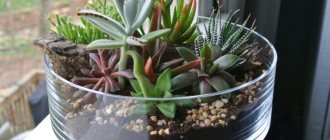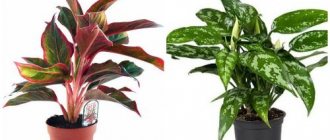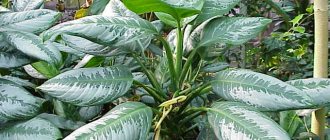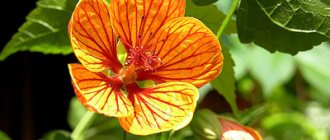Home » Flowers and plants » Indoor plants
Irina Borodina 06/01/2020
10871 Views 2 comments
The myrtle tree, originally from the Mediterranean, fell into the ranks of indoor plants not by chance. It not only decorates the room, but gives it a special style, fitting perfectly into the interior of modern apartments.
Can be cut, standard ones are found in the shape of a ball, cube, or cone. It can be grown as a shrub or tree.
And the myrtle bonsai looks exotic. The leaves contain essential oils that purify the air.
Features of growing a myrtle tree are in our article.
Beneficial properties and harm of myrtle
Myrtus is a medicinal plant whose beneficial properties are used in medicine.
- Essential oils exuded from the leaves are natural phytoncides that disinfect the surrounding air.
- An astringent and bactericidal effect helps relieve inflammation and heal wounds.
- Increases body tone, improves immunity.
- Helps with skin diseases: dermatitis, psoriasis; cosmetology.
- Stimulates the nervous system.
In addition to its beneficial properties, the flower can cause harm to humans:
- It is not recommended to place indoor myrtle in the bedroom - its pine aroma can cause insomnia and headaches.
- Medicines based on myrtle have a tonic effect, so they are not used before bedtime.
- The use of drugs in children and pregnant women is contraindicated.
The most popular types and varieties of myrtle
The following types of myrtle are kept indoors. Photo below.
Common myrtle
It has a short trunk covered with scaly, peeling bark. The leaves are brilliantly located opposite each other. The flowers are white with long yellow stamens protruding beyond the corolla.
At home, both the botanical species and varieties of common myrtle are grown.
The following varieties are most commonly found.
Tarentina
A low-growing variety characterized by dwarf size and abundant flowering.
Variegata
The leaves differ in color; they are variegated, green and white.
Chilean myrtle (Luma apiculata)
This species is represented by slowly growing trees reaching 10 - 20 meters in height. The trunks are twisted, with smooth bark. The berries of Chilean myrtle are edible and have medicinal properties, which is why they are used in medicine.
Dwarf forms are grown as indoor plants.
Glanleam Gold
Variegated form of Chilean myrtle. It is small in size.
How to care for myrtle
The myrtle tree is quite picky in its content. Therefore, for successful growth, he is provided with proper care at home.
The soil
The plant prefers soil with high acidity. The mixture consists of the following components:
- turf land;
- compost soil or manure humus;
- peat;
- coarse sand.
All parts are taken in equal quantities.
This substrate is suitable for both adult plants and young seedlings.
Watering
- Water the plantings in a timely manner - even short-term drying out of the soil can trigger the shedding of leaves. If this happens, do not worry too much - the tree will grow again.
- Adding hydrogel to the soil will allow the soil to better retain moisture.
- It is useful to alternate watering with regular soft water and water acidified with lemon juice. To prepare the solution, add 2-3 drops of lemon juice to 1 liter of water.
- The home bush responds gratefully to spraying and cool showers.
Lighting, temperature
- The culture feels most comfortable in bright light, at moderate temperatures, about 18 - 23 C. The plant is covered from the scorching sun to prevent overheating. In summer it is taken out into the open air.
- The ideal option for keeping an indoor tree is a warm loggia or a bright, unheated room.
- Sometimes when Myrtus dries out, it is enough to take it into a cooler room to make it feel better.
- In winter, it is provided with a temperature of about 10 - 12 C. Watering for this period is limited, but without drying out the earthen coma.
Soil for citrus fruits
Fans of home floriculture are well aware that growing citrus fruits is a troublesome and difficult task, but very exciting. You can admire lemons or tangerines on the windowsill at any time of the year. Some fruits even have good taste and are quite suitable for the holiday table. Of course, we are not talking about commercial products. Domestic citrus trees are more decorative and are grown to decorate the interior.
How to choose the right soil mixture
One of the most important components of the successful cultivation of these rather capricious crops is the composition of the soil. The soil must be sufficiently nutritious, light and permeable to moisture and air. Considering that it is not recommended to loosen the surface layer, special loosening agents are added to the mixture.
Propagation of indoor myrtle
Myrtaceae propagate by cuttings and seeds.
Growing from seeds
The seeds must be fresh, their germination depends on this.
A mixture of the following composition is suitable for sowing:
- Peat soil;
- sand (vermiculite).
- Take the same amount of components and mix thoroughly. The result is a loose air mixture, which is watered with a fungicide solution (Fitosporin) to prevent fungal infections.
- The seeds are distributed over the surface of the substrate, then lightly sprinkled with a layer of soil.
- Cover with a transparent lid.
- The crops are periodically ventilated to prevent mold from appearing on the surface.
- The soil is kept moist.
- Shoots appear in 1 - 2 weeks, at a temperature not lower than 20 C. Bottom heating is desirable.
- After the true leaves appear, the seedlings must be transplanted into nutrient soil. Since the substrate in which the seeds sprouted is poor in nutrients.
Transplantation is stressful for young plants - they temporarily stop growing. But after adaptation, they begin to grow again.
Propagation by cuttings
When cutting, a non-lignified branch with a “heel” is separated from an adult tree. For successful rooting, the cut must be treated with stimulants: Epin, Zircon. Without the use of such phytohormones, attempts are doomed to failure.
Good results are achieved by using sphagnum moss. By its nature, it is breathable, retains water well, and most importantly, it has bactericidal properties and does not allow the shoots to rot.
Moss saturated with water is placed in a container and the treated cuttings are planted. The top is covered with a cap, which is periodically removed to ventilate.
Transfer
You should not replant myrtle immediately after radical pruning. Both are stressful for the plant. As soon as it moves away from the swift and begins to grow, it will be possible to replant.
A pot that is too spacious will not work. Usually the same one in which the myrtle grew is enough. You need to shake off the old soil or soak it in water. If you prefer compact plants, provide a tight container. Trim overgrown roots if necessary.
The soil is suitable for any commercial soil for decorative foliage plants. You can also use your own prepared from humus (1 part), garden soil (2 parts) and sand (1 part).
Why do myrtle leaves fall off?
Myrtus is very sensitive to environmental factors. Sometimes it happens that a myrtle tree loses its leaves. This phenomenon may be influenced by certain factors or a combination of them.
- Drying of the earthen coma.
- We moved the pot to a new place.
- A newly purchased plant stays in the same soil for a long time. It is advisable to transplant newly acquired trees into fresh soil, since there is a high probability that the previous substrate has already been depleted.
- Stress after an inaccurate transplant.
- High ambient temperature.
- Warm wintering.
However, it happens that the reset occurs for an unexplained reason. But the bush will grow leaves again - Epin helps the tree turn green again.
Crown formation
Without trimming, the crown grows loose and sparse. And regular pruning makes indoor myrtle even more attractive. Dwarf forms make beautiful bonsai.
It must be borne in mind that buds appear on young shoots. Therefore, in order for myrtus to bloom, you should not cut off the branches of the current year. The haircut is carried out at the end of flowering.
There are several ways to form a crown.
Standard
When the trunk reaches the desired height, the lower branches are removed. The upper branches are carefully trimmed to achieve the desired shape.
Round
This option is convenient if the seedling for some reason has lost the crown and has 2 central branches. The branches are directed along a round support in different directions and secured with twine. The side branches are shortened, which promotes branching.
Bloom
If you want myrtle to bloom, you don't need to prune it in the spring.
When the plant blooms (flowering period), flower shape
Flowering period is June and July. At this time, the flower requires increased watering and fresh air. Some gardeners take myrtle to the dacha and dig the pot into the garden bed so that it is not exposed to direct sunlight, but has enough light.
Myrtle flowers are small, delicate, white or pink. The main part of the flowers is located on the upper part of the crown. They come in regular and terry types.
Plant care after flowering
After flowering ends, watering and fertilizing are gradually reduced. In autumn the crown is pruned.
Problems, diseases and pests of a flower
If myrtle is cared for well, it will not face any trouble. It can only suffer from overwatering, then the roots begin to rot and the plant dies.
If the indoor air is too dry, myrtle may become susceptible to pests. It is affected by aphids, scale insects and spider mites.
- Scale insects or shield aphids attack leaves and stems. Measures to combat it are spraying with a soap and tobacco solution with the addition of kerosene. The pests themselves are removed with a damp swab, and spraying with an insecticide saves from the larvae.
- Spider mites appear if the indoor air is too dry. You can get rid of it by washing the leaves (their lower side) with a soap solution or weak tobacco infusion. Insecticides can be used.
- Aphids infect the leaves - they begin to curl and dry out. Treated with insecticides.
Diseases and pests of myrtle
- One of the most unpleasant pests is the scale insect. Due to the fact that the plant has many small leaves, manually getting rid of it is problematic. An effective option would be radical pruning. Such an event will remove most of the scale insects and provide access to difficult places for processing. Then the bush is treated with drugs.
- Spider mites reveal themselves by yellowing and falling leaves.
- Traditional methods or acaricides are used against ticks.
An educational video will show you how to care for indoor myrtle.
Landing
Planting myrtle
quite an easy procedure. It is best to use cuttings for this (a lot of troubles can arise with seeds).
The cutting will be able to take root very quickly if it is placed in a container of water. As soon as the first shoots begin to appear, you can start planting the flower.
If you pluck the branches in the middle or end of the spring season, you significantly increase the likelihood that after planting the plant, the myrtle will grow lush and healthy.
Typically, plant growth can last from 3 to 5 years.
Location and lighting
After the myrtle has been planted, you need to think about where to place it in the house. The most suitable option may be window sills, which will be located from the west or east. If this is not possible, and you have to place the flower on the south side, then it is necessary to protect the plant from direct rays of the sun. Otherwise, the myrtle will not bloom, and its leaves will quickly fade.











